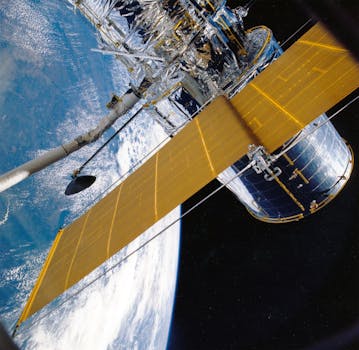From Geostationary to Low Earth Orbit: The Evolution of Satellite Telecommunications in 2023

From Geostationary to Low Earth Orbit: The Evolution of Satellite Telecommunications in 2023
The satellite telecommunications industry has undergone significant changes in recent years, with a shift from geostationary to low Earth orbit satellites. This evolution has brought about numerous benefits, including improved connectivity, increased bandwidth, and reduced latency. In this article, we will explore the history of satellite telecommunications, the advantages of low Earth orbit satellites, and the current state of the industry.
History of Satellite Telecommunications
Satellite telecommunications have been around for several decades, with the first commercial satellite, Intelsat 1, launched in 1965. These early satellites were placed in geostationary orbit, which is approximately 36,000 kilometers above the Earth’s equator. Geostationary satellites have the advantage of being able to cover a large portion of the Earth’s surface, making them ideal for broadcasting and telecommunications. However, they also have some significant limitations, including high latency and limited bandwidth.
Advantages of Low Earth Orbit Satellites
In recent years, there has been a shift towards low Earth orbit (LEO) satellites, which are placed in orbit at an altitude of around 160 to 2,000 kilometers. LEO satellites have several advantages over geostationary satellites, including lower latency, higher bandwidth, and improved connectivity. They are also less expensive to launch and operate, making them an attractive option for companies looking to provide satellite telecommunications services. One of the main benefits of LEO satellites is their ability to provide high-speed internet connectivity to remote and underserved areas, where traditional telecommunications infrastructure is lacking.
Current State of the Industry
The satellite telecommunications industry is currently undergoing rapid growth and transformation, driven by advances in technology and the increasing demand for high-speed internet connectivity. Several companies, including SpaceX, OneWeb, and Amazon’s Kuiper Systems, are launching constellations of LEO satellites to provide global internet coverage. These constellations are designed to provide high-speed, low-latency connectivity to anyone, anywhere in the world, and have the potential to revolutionize the way we communicate and access information.
According to a report by MarketsandMarkets, the global satellite telecommunications market is expected to grow from USD 4.3 billion in 2020 to USD 12.8 billion by 2025, at a Compound Annual Growth Rate (CAGR) of 24.8% during the forecast period. This growth is driven by the increasing demand for high-speed internet connectivity, the adoption of LEO satellites, and the growing need for satellite-based services in various industries, including maritime, aviation, and emergency response.
Conclusion
In conclusion, the evolution of satellite telecommunications from geostationary to low Earth orbit has brought about numerous benefits, including improved connectivity, increased bandwidth, and reduced latency. The current state of the industry is characterized by rapid growth and transformation, driven by advances in technology and the increasing demand for high-speed internet connectivity. As the industry continues to evolve, we can expect to see new and innovative applications of satellite telecommunications, including the provision of high-speed internet connectivity to remote and underserved areas, and the development of new satellite-based services.




